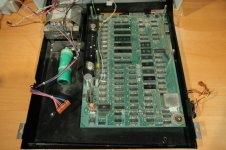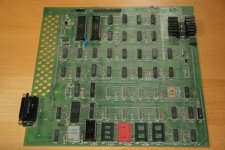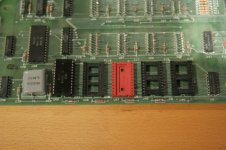Rick Thornquist
Member
The good news: A friend gave me a SuperPET!
The bad news: It's not working. When I plug it in and turn it on it does nothing. No chirp, no whine from the monitor, no display from the monitor, no nothing.
It's the single daughterboard version and in very nice shape. I checked for burst caps and bad connections - everything looked good. I checked all of the connectors and socketed chips - they all looked fine. I disconnected and reconnected the connectors and pulled out and put back in the socketed chips and tried turning it on again. Still no dice.
I then checked is the transformer. I am getting power from it and the voltages seem close enough. Here's what I got:
4-6 17.2VAC
4-5 8.6VAC
5-6 8.6VAC
7-8 16.2VAC
9-11 21.1VAC
There are two things that looks slightly amiss, but I'm not sure if they are a problem or not. On the motherboard, I have chips in UA3 and UD7 but not in UD11 or UD12. On the daughterboard, I have a chip in U49 but none in U48, U47 (where, oddly, the socket is red), U46 or U45. Also, there is a red wire and a black wire hanging down from the bottom of the keyboard. In pictures it looks like both are connected at both ends, but in my machine one end of each wire is free.
I'd very much appreciate some suggestions as to what I should check next. Thanks!
- Rick
The bad news: It's not working. When I plug it in and turn it on it does nothing. No chirp, no whine from the monitor, no display from the monitor, no nothing.
It's the single daughterboard version and in very nice shape. I checked for burst caps and bad connections - everything looked good. I checked all of the connectors and socketed chips - they all looked fine. I disconnected and reconnected the connectors and pulled out and put back in the socketed chips and tried turning it on again. Still no dice.
I then checked is the transformer. I am getting power from it and the voltages seem close enough. Here's what I got:
4-6 17.2VAC
4-5 8.6VAC
5-6 8.6VAC
7-8 16.2VAC
9-11 21.1VAC
There are two things that looks slightly amiss, but I'm not sure if they are a problem or not. On the motherboard, I have chips in UA3 and UD7 but not in UD11 or UD12. On the daughterboard, I have a chip in U49 but none in U48, U47 (where, oddly, the socket is red), U46 or U45. Also, there is a red wire and a black wire hanging down from the bottom of the keyboard. In pictures it looks like both are connected at both ends, but in my machine one end of each wire is free.
I'd very much appreciate some suggestions as to what I should check next. Thanks!
- Rick




